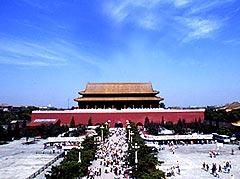 The ancient imperial structures of Beijing's Forbidden City, viewed daily by thousands, will be restored to their original grandeur as the city undertakes a massive restoration of China's largest palace museum.
The ancient imperial structures of Beijing's Forbidden City, viewed daily by thousands, will be restored to their original grandeur as the city undertakes a massive restoration of China's largest palace museum.
As a prelude to revamping the entire palace museum, located at the north end of Tiananmen Square, the renovation of Wuying Palace, located in the museum's unopened area, began last Thursday.
Jin Hongkui, deputy director of the Palace Museum, said that itis the first time the museum will have been overhauled since 1911 and the whole project is expected to be accomplished in seven years.
The Forbidden City, built during the Ming (1368-1644) and Qing (1644-1911) dynasties, covers an area of 720,000 square meters and has more than 8,700 rooms.
"We are trying to restore the imperial city's original appearance before the opening of the 2008 Olympics," said Jin.
Wuying Palace was destroyed by fire during the Ming and Qing dynasties and it has been renovated nine times since the Palace Museum was founded in 1925.
The major renovation work on Wuying Palace involves replacing glazed tiles of the main buildings and rehabilitating the colored paintings and air slaked stone inscriptions.
Modern science and technology will be used to maintain the original architectural style, according to Jin.
The Palace Museum, with a collection of millions of treasures from the imperial palaces of the Ming and Qing dynasties, was given State cultural heritage protection in 1949 and listed as a world Cultural Heritage Site by the UNESCO in 1987.
(People's Daily October 22, 2002)
|

